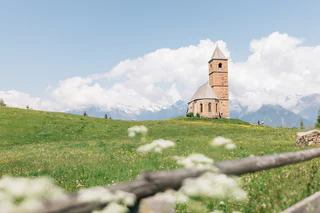
1/5
St. Kathrein church
Santa Caterina/St. Kathrein, Hafling/Avelengo, Meran/Merano and environs
V Jižním Tyrolsku jsou místa, která vyzařují zvláštní energii. V tichu lesa, na vyvýšených vyhlídkách nebo za zdmi kláštera – tam všude můžete naslouchat svému nitru a načerpat nové síly.

1/5
Santa Caterina/St. Kathrein, Hafling/Avelengo, Meran/Merano and environs

Valles/Vals, Mühlbach/Rio di Pusteria, Brixen/Bressanone and environs

Dobbiaco Nuova/Neutoblach, Toblach/Dobbiaco, Dolomites Region 3 Zinnen

Aquaviva/Ackpfeif, Lana, Meran/Merano and environs

1/2
Plars di Mezzo/Mitterplars, Algund/Lagundo, Meran/Merano and environs

1/11
Cologna/Glaning, Jenesien/San Genesio Atesino, Bolzano/Bozen and environs

1/7
Ortisei/Urtijëi/St. Ulrich/Urtijëi, Urtijëi/Ortisei, Dolomites Region Val Gardena

1/4
Aquaviva/Ackpfeif, Lana, Meran/Merano and environs

1/6
Caldaro Paese/Kaltern Dorf, Kaltern an der Weinstraße/Caldaro sulla Strada del Vino, Alto Adige Wine Road

1/2
Nova Ponente Centro/Deutschnofen Dorf, Deutschnofen/Nova Ponente, Dolomites Region Eggental

1/4
Meltina/Mölten, Mölten/Meltina, Bolzano/Bozen and environs

1/5
Stanghe/Stange, Ratschings/Racines, Sterzing/Vipiteno and environs

1/11
Tablà/Tabland - Parcines/Partschins, Partschins/Parcines, Meran/Merano and environs

1/2
Penone/Penon, Kurtatsch an der Weinstraße/Cortaccia sulla Strada del Vino, Alto Adige Wine Road

Tiso/Teis, Villnöss/Funes, Dolomites Region Villnösstal

1/6
Castelvecchio/Altenburg, Kaltern an der Weinstraße/Caldaro sulla Strada del Vino, Alto Adige Wine Road

1/5
Colma/Kollmann, Barbian/Barbiano, Brixen/Bressanone and environs

1/3
Pietrarossa/Rotwand, Ritten/Renon, Bolzano/Bozen and environs

1/7
Pinzano/Pinzon, Auer/Ora, Alto Adige Wine Road

1/3
Prati/Auen, Sarntal/Sarentino, Meran/Merano and environs

1/4
Alpe di Siusi/Seiseralm, Kastelruth/Castelrotto, Dolomites Region Seiser Alm

1/2
Braies di Fuori/Ausserprags, Prags/Braies, Dolomites Region 3 Zinnen

1/5
Albion/Albions, Lajen/Laion, Dolomites Region Val Gardena

Siusi/Seis, Kastelruth/Castelrotto, Dolomites Region Seiser Alm

Santa Gertrude/St. Gertraud, Ulten/Ultimo, Meran/Merano and environs

Auna di Sotto/Unterinn, Ritten/Renon, Bolzano/Bozen and environs

S. Andrea/St. Andrä, Brixen/Bressanone, Brixen/Bressanone and environs

Varna/Vahrn, Vahrn/Varna, Brixen/Bressanone and environs

Villabassa/Niederdorf, Niederdorf/Villabassa, Dolomites Region 3 Zinnen

1/3
Madonna/Unser Frau, Schnals/Senales, Vinschgau/Val Venosta